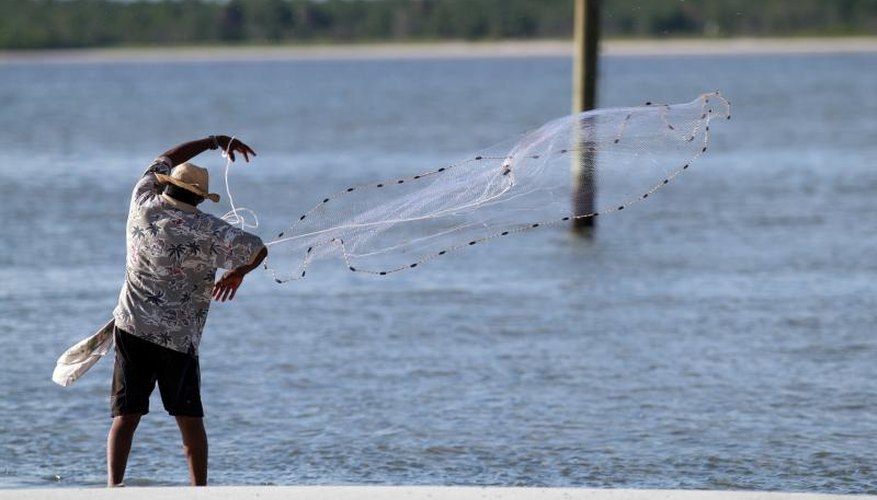
Florida mullet are among the largest and -- locals claim -- the tastiest anywhere, and mullet fishing is a time-honored way to put food on the table or pit your skills against a lively, keen-eyed fighter. Recreational fishers in Florida can test their skills against the mullet's wiles from the beach, the dock or an open boat. Most residents between the ages of 16 and 65 need a state fishing license, easily obtained under Florida Fish and Wildlife Conservation Commission regulations. Some out-of-state visitors may be required to produce a valid fishing license from their state.
Rules and Limits
Striped or black, silver, fantail and red-eye mullet thrive in the bays, estuaries, creeks, rivers and coastal waters of Florida, eating mostly algae, marine vegetation and bottom scavenge. They were once so plentiful that you could see great shoals of them roiling the water and leaping into the air at dusk and dawn, or watch an impenetrable mass of mullet sweep by in crystal clear water. Today, after decades of over-fishing, commercial mullet fishing is regulated in Florida, but the fish are not endangered, and recreational fishing has only seasonal bag and gear limits. Spear fishing is not allowed in fresh water. Smaller cast and seine nets, hook and line, and gigs are fine everywhere, and spear fishing is permitted in salt water. The daily bag limit is 50 fish per person, with vessel limits of 50 from Sept.1 to Jan. 31, and 100 fish from Feb. 1 to Aug. 1 in most of the state.
Cane Poles and Fly Casting
Time was in Florida you couldn't see a canal bank or a bridge without a row of cane poles and a row of baskets full of fresh-caught mullet, destined for dinner. Cane poles are still effective for catching mullet. Chum the area with a mash of chicken feed, oats and water; roll tiny balls of the chum to put on your hook and cast it into the cloud of dissolving chum. Watch for your bobber to dip slightly or "feel" the vibration, and set the hook fast and hard, or you'll lose the fish. Fly-casting makes it more of a sport but chumming increases your odds of success. Use a cork or bobber with a line of small hooks beneath it, baited with skinny slivers of white or tan plastic worm or tied flies that look like falling chum in the water. Keep the string vertical with a very light sinker, cast and let the hooks sink down to entice bottom feeders.
Cast a Modest Net
Cast nets of up to 14 feet are allowed in fresh and salt water. Nets are especially effective for mullet runs during the autumn migration along the shore when large schools of fish return to Florida, preparing to spawn offshore. A frenzy at the water's surface means a quick toss of the net will likely yield a number of small bait mullet or a few larger, edible fish. Mullet hug seawalls, so you can cast right from a wall or dock. In fresh or still water, chum the area to attract a school of fish within reach of your net, but be aware that mullet have keen eyesight and will dart away from the net quickly.
Seining in the Surf
Seine nets under 500 square feet take two people to haul in a catch. Set the net off the beach at the change of tide -- an hour or more after high tide or low tide when the water is moving -- and leave it for no more than an hour. Or walk the net, each person holding a pole, until you have a decent catch. Walk it closed and bring it to shore.
Bait Fish and Cheese Grits
Grouper, snapper, mahi-mahi, Spanish mackerel and large game fish will go for dead finger mullet -- immature adolescents -- and small live mullets. As bait fish, mullet is plentiful, cheap and effective -- you can keep cast-net finger mullets alive in a bucket of water overnight so they are fresh for early morning fishing. But mullet -- an oily, flavorful fish -- is pretty good eating, too. Breaded and fried mullet filets, hot sauce, hush puppies and cheese grits is a classic local Floridian meal. Smoked mullet has a strong flavor; the fish can be added to stews. Mullet roe is considered a great delicacy in Asia and is smoked or fried for local consumption along Florida's coasts and waterways, where it's caught.
References
Writer Bio
Benna Crawford has been a journalist and New York-based writer since 1997. Her work has appeared in USA Today, the San Francisco Chronicle, The New York Times, and in professional journals and trade publications. Crawford has a degree in theater, is a certified Prana Yoga instructor, and writes about fitness, performing and decorative arts, culture, sports, business and education .



